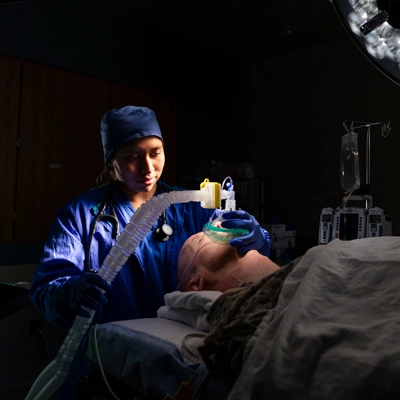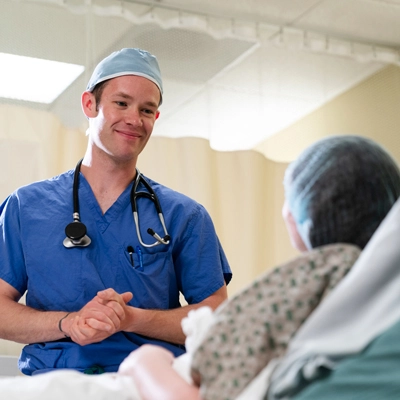What's It Like to Be a CRNA?
by Bill Prosser, DNAP, MSN, CRNA

Being a Certified Registered Nurse Anesthetist (CRNA) is an incredible combination of high-level scientific expertise, intense responsibility, and unfailing personal patient advocacy. It’s one of the most challenging and rewarding careers in healthcare, demanding constant vigilance, critical thinking, and an unwavering commitment to safety. For many of us, it’s not just a job; it's a calling that offers profound personal satisfaction every single day.
The commitment required for this advanced role is reflected in its standing within the healthcare system. According to the U.S. Bureau of Labor Statistics (BLS), CRNAs are among the highest-paid professionals in the nursing field, reporting a median annual salary of $223,210. In my personal experience and discussion with colleagues and others, this is a very low number.
Moreover, the job outlook is exceptionally secure, with the BLS projecting employment growth of 35% from 2024 to 2034 – a rate considered much faster than the average for all occupations. This high demand underscores the critical nature of the role.
A Day in the Life of a Nurse Anesthetist
A CRNA's workday starts long before the first patient is wheeled into the operating room – sometimes the day before if the case complexity requires early collaboration between anesthesia and surgery. The typical anesthesia work day starts early, because preparation is non-negotiable and the surgical day starts early.
The Preparation and Ritual
My morning begins with the anesthesia machine check. I treat this like a pilot’s pre-flight inspection – it's a meticulous ritual where every tube, valve and monitor must be verified. My ability to keep a patient safe depends entirely on the flawless function of that equipment. I have to trust it completely, and that trust starts with my personal confirmation.
The Human Moment
Next, I meet the patient. This is, for me, the most important part of the job. A patient scheduled for surgery is often at their most vulnerable – scared, anxious, and filled with questions. My job in those few minutes is to be the calmest, most confident person they've ever met. I sit down, explain the anesthesia plan in plain language, answer their questions, offer reasonable options and give them a simple, powerful promise: "I’ll be right here, watching you the whole time." That quick connection and trust-building isn’t clinical filler; it’s the bedrock of safe anesthesia care.
The Silent Guardian
Once in the operating room, my world narrows entirely to the patient’s physiological state. While the surgeon focuses on the anatomy and the procedure, the anesthesia team is the expert on the patient's overall well-being. I'm at the head of the bed, monitoring vitals, managing medication infusions, and making minute-by-minute adjustments to ensure stability. It’s an intense, continuous process, like playing a very serious, high-stakes game where you have to anticipate problems before they even appear. You are their silent, constant guardian.
The Safe Landing
After the surgery, the focus shifts to a smooth, controlled emergence from anesthesia. I carefully reverse the agents, manage their pain and nausea, and ensure they wake up gently. Seeing a patient open their eyes, comfortable and grateful, is truly the best feeling in the world. My job isn't done until I've given a thorough report to the recovery room staff, ensuring their postoperative management strategy is best for their recovery.
The Landscape of Practice: Urban, Rural and Office Settings
One of the great strengths of the CRNA profession is its versatility. The type of setting you choose drastically influences your daily work, autonomy and lifestyle. Most CRNAs work 40 to 50 hours per week with call and extra shifts if desired.
Urban Hospitals and Trauma Centers
This environment is fast-paced and complex. You are dealing with the highest-acuity cases – cardiac, neurosurgery, major trauma. CRNAs here typically work as part of a large Anesthesia Care Team (ACT), collaborating closely with physician anesthesiologists. The schedules are demanding, frequently requiring nights, weekends, and on-call shifts to cover the continuous nature of emergency care.
Related: CRNA vs. Anesthesiologist Assistant vs. Anesthesiologist
Rural Hospitals and Community Centers
The dynamic is very different in this practice environment, where CRNAs are often the sole anesthesia provider, granting high or full autonomy. You might handle a wide range of cases, from general surgery to labor and delivery. Your clinical independence is maximal, and your impact is profound; you are a primary reason that the community can offer surgical services. The on-call duties are frequent, but the deep personal satisfaction of serving an underserved area is immense.
Office-Based Practices
This is often the path chosen by CRNAs seeking work-life balance. These settings – like plastic surgery, dental, or pain management clinics – offer lower-acuity procedures and, crucially, highly predictable hours. Most office-based practices operate during standard business hours; this usually means no nights, weekends or on-call work, providing a welcomed relief from the hospital grind.

Collaboration, Autonomy, and Leadership
The relationship between the anesthesia team and the surgical team is built on distinct yet collaborative expertise. The surgeon is the expert on the procedural intervention, but the anesthesia provider is the expert on the patient's physiological well-being and managing that physiology during the entire perioperative period.
We are constantly assessing the patient's tolerance for the procedure, managing blood loss, regulating vital signs, and ensuring stability. For a successful outcome, the whole team needs to communicate and collaborate seamlessly. Because of our experience across all types of cases and our training in advanced practice, CRNAs become natural leaders who drive systemic improvements.
Beyond the Bedside
My leadership role extends beyond directing a crisis at the bedside. You get tired of seeing the same safety gaps or inefficiencies, so you step up. We become change agents because we possess the credibility and practical knowledge to say, "I saw this happen, and here is a policy that will prevent it." We are trusted voices at the leadership table, advocating for better patient care protocols, improving efficiency and outcomes while ensuring the highest safety standards in the hospital.
Pioneering Research
CRNAs are also actively involved in the advancement of our profession. We take our real-world questions and translate them into research, studying new techniques and advancing the science of anesthesia. This could involve investigating new pain management strategies or developing improved methods for patient monitoring. We are not just practicing medicine and nursing; we are contributing to its evolution by melding the best of both disciplines.
Political Involvement and Advocacy
Beyond the clinical setting, CRNAs are highly active in the political arena, recognizing that their scope of practice is often determined by state and federal legislation. This involvement centers on protecting and advancing patient access to full-scope anesthesia care. Through organizations like the American Association of Nurse Anesthesiology (AANA), CRNAs lobby Congress and state legislatures to remove outdated barriers to practice that restrict CRNA autonomy. Their advocacy focuses on ensuring that policy reflects the high standard of safety and quality demonstrated by CRNAs, particularly in rural and underserved areas where they are often the sole anesthesia provider.
By engaging politically, CRNAs secure their ability to practice to the full extent of their education and training, which directly translates to better, more efficient patient care across the healthcare system.
Moral and Ethical Obligations
The responsibility inherent in anesthesia care carries a significant moral and ethical weight that guides every decision, often under intense pressure.
The Duty of Full Disclosure
Our first ethical obligation is to respect patient autonomy through careful and thorough informed consent. This goes beyond reading a form; it requires practicing radical honesty. When a patient is elderly, complex or facing a highly risky surgery, the CRNA must ensure the patient comprehends the nuanced risks and benefits of the anesthetic plan in relation to their pre-existing health. This requires patience, clarity and the courage to stop the process if genuine understanding is lacking.
Non-Negotiable Advocacy for Safety
Perhaps the most challenging ethical duty is patient advocacy when it conflicts with institutional or surgical pressure. It is the CRNA's moral imperative to be the final safety valve. If a patient is not optimally prepared, if equipment fails the pre-use check, or if a critical monitor malfunctions, the CRNA must be prepared to delay or even cancel the case – regardless of the consequences to the surgical schedule or the team's frustrations. The decision to prioritize safety over speed is the ultimate ethical test of the profession.
Resource Stewardship and Justice
In the rural or underserved settings where CRNAs often function autonomously, the ethical challenge shifts to resource allocation. The CRNA must make high-stakes decisions with limited access to blood products, specialized monitoring, or backup staff. There is an ethical burden to maximize care under suboptimal conditions, requiring not only technical skill but profound moral resolve. Furthermore, we maintain an ethical duty to combat disparities by providing the same standard of vigilant care to every person, regardless of demographic or circumstance.
The Reward: More Than Just a Paycheck
This is a stressful but highly rewarding job. The responsibility for human life is monumental. The long hours, the on-call burden, and the mental stamina required are challenging.
But the personal rewards are what truly define the career and what keep us dedicated:
- The Ultimate Patient Advocacy:Knowing that during a patient's most vulnerable moment, you were their protector. That feeling is unmatched.
- Mastery and Innovation:We actively use modern techniques, such as ultrasound-guided nerve blocks and point-of-care ultrasound (POCUS) using synergistic non-opioid medications, to essentially eliminate postoperative pain for many patients. We use cutting-edge science to deliver a better, faster, and safer recovery. This sense of mastery and successful innovation is incredibly gratifying.
- The Leadership Impact:Knowing that your practical advocacy and leadership have made the entire hospital system safer for everyone who walks through its doors is a deep, abiding reward.
Who Makes a Great CRNA?
This is the job for a special kind of person. You must be incredibly detail-oriented, able to process complex information rapidly, and have the mental fortitude to be calm and decisive under pressure.
You need to be confident enough to make independent decisions but humble enough to seek counsel.
And, fundamentally, you have to be compassionate. The technical skills are learned, but the core heart of the job is the unwavering drive to care for people.

The high employment growth rate projected by the BLS proves that the healthcare system increasingly values these specific skills.
The typical full-time schedule is demanding, but flexibility exists. Many CRNAs successfully find work-life balance by choosing those office-based or travel positions.
In the end, becoming a CRNA is a huge commitment and societal obligation. But if you’re looking for a career that offers profound personal rewards, intellectual challenge, immense professional respect, and the daily knowledge that you are a life-saving expert and leader, then this might just be the one for you.
Learn more about how to become a CRNA in Oregon